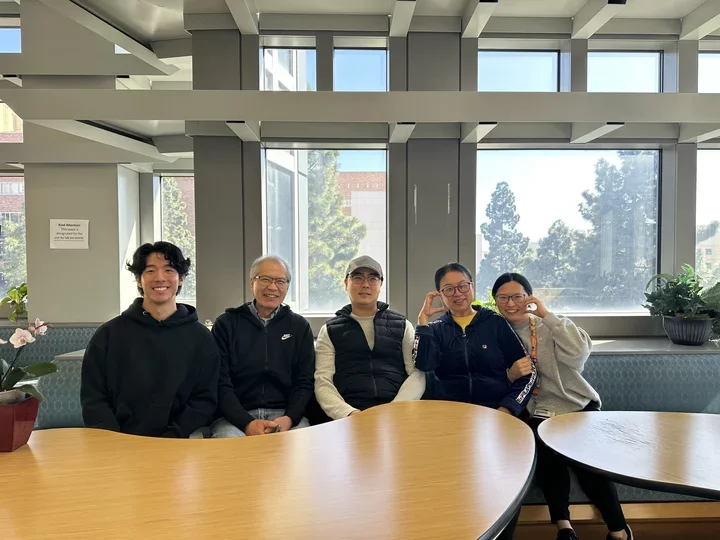Fong Research Lab
About Our Research
The Fong laboratory focuses on two topics: the molecular physiology of the nuclear lamina and mechanisms of triglyceride-rich lipoprotein metabolism.
The nuclear lamina is a protein meshwork located adjacent to the inner nuclear membrane that provides structural support and organization for the nucleus. The principal proteins of the nuclear lamina in somatic cells are the A-type (lamins A and C) and B-type (lamins B1 and B2) nuclear lamins. Mutations in LMNA (the gene for lamin A and lamin C) have been linked to multiple human diseases (or “laminopathies”), including lipodystrophy, cardiomyopathy, muscular dystrophy, and premature aging syndromes.
Our studies of the nuclear lamina are guided by dual objectives—to understand the role of the A-type nuclear lamins in health and disease and to investigate the pathogenesis of the pediatric premature aging disease Hutchinson-Gilford progeria syndrome (HGPS).
We have made progress towards both objectives.
We established that the two protein products of Lmna (lamin A and lamin C) are dispensable as long as one is produced in normal amounts—the synthesis of only lamin A or only lamin C does not lead to disease and does not affect the vitality of mice. We showed that the farnesylated form of prelamin A (which is normally processed to mature lamin A) is toxic and is responsible for all disease phenotypes in Zmpste24–/– mice (a model of progeria). Based on this discovery, we hypothesized that the farnesyl group on progerin (the mutant prelamin A protein in HGPS) might be responsible for progerin’s toxicity and that inhibiting protein farnesylation might minimize disease severity. Indeed, this was the case. We were the first to show that treatment of HGPS fibroblasts with a protein farnesyltransferase inhibitor (FTI) improved the hallmark nuclear shape abnormalities in HGPS fibroblasts and the first to demonstrate that FTI treatment ameliorates disease phenotypes and extends lifespan in mouse models of progeria.
These studies laid the foundation for the first clinical trial of a therapeutic approach to treat children with HGPS. Of note, lonafarnib (an FTI) was granted approval by the FDA to treat HGPS in November 2020. Our current research program focuses on investigating the molecular mechanisms underlying vascular disease in HGPS, and investigating the importance of nuclear lamins in the integrity of the nuclear envelope, cell division, and cell survival.
Our work on triglyceride metabolism has been equally satisfying.
Dr. Fong, along with UCLA colleagues (Drs. Stephen Young and Anne Beigneux), discovered that GPIHBP1, a GPI-anchored endothelial cell protein, is essential for the metabolism of triglyceride-rich lipoproteins (TRLs) by the enzyme lipoprotein lipase (LPL). In 2010, Dr. Fong’s laboratory identified GPIHBP1’s main function—to transport LPL across the capillary wall. In lipolytic tissues, such as the heart, brown adipose tissue and skeletal muscle, GPIHBP1 captures LPL secreted into the interstitial spaces by adipocytes and myocytes, and shuttles it across endothelial cells to its site of action in the capillary lumen. In the absence of GPIHBP1, LPL remains stranded in the interstitial spaces, and the metabolism of TRLs (i.e., chylomicrons and VLDL) is severely impaired, resulting in hypertriglyceridemia. This is true both in mice and humans. Later, they showed that the binding of TRLs along the capillary lumen is dependent on the transport of LPL into the capillary lumen by GPIHBP1. When LPL is absent, lipoproteins do not stop along capillaries, but just flow on by. These discoveries explain the hypertriglyceridemia in GPIHBP1-deficiency.
The Fong laboratory also developed reagents (e.g., the monoclonal antibody 11A12 against GPIHBP1) and approaches to visualize and quantify levels of LPL and GPIHBP1 inside capillaries of tissues in vivo.
These advances in the lipid metabolism field will be important for future studies investigating mechanisms of hypertriglyceridemia, and identifying cellular events regulating intravascular LPL levels in tissues and TRL metabolism in health and disease.
- New publication. "The Accumulation of Progerin Underlies the Loss of Aortic Smooth Muscle Cells in Hutchinson-Gilford Progeria Syndrome." Paul Kim et al., Cell Death and Disease 2025
- Congratulations and Good Luck! Best wishes to Paul Kim and Joonyoung Kim as they embark on their newest journeys. Paul is a postdoctoral fellow at the Sandia National Laboratories in Livermore California and Joonyoung will start medical studies at George Washington School of Medicine in Washington D.C. We wish them the very best and much success!
- New publication. "Distinct strategies for intravascular triglyceride metabolism in hearts of mammals and lower vertebrate species." Le Phuong Nguyen et al., JCI Insight 2024
- May 2024: Paul Kim successfully defends his Ph.D. thesis, "Underlying mechanisms of vascular disease in Hutchinson-Gilford progeria syndrome." Congratulations to Paul on a job well done!
- New publication. "Progerin forms an abnormal meshwork and has a dominant-negative effect on the nuclear lamina." Paul Kim et al., PNAS 2024
- New RO1 grant. "Solving longstanding mysteries in plasma triglyceride metabolism" Jan 2024
- New Leducq Foundation grant. "Intravascular lipolysis and cardiometabolic disease: molecular physiology, vascular biology, and therapeutics" Jan 2024
Principal Investigator
Loren Fong
lfong@mednet.ucla.edu
Collaborators
Anne Beigneux
abeigneux@mednet.ucla.edu
Stephen G. Young
sgyoung@mednet.ucla.edu
